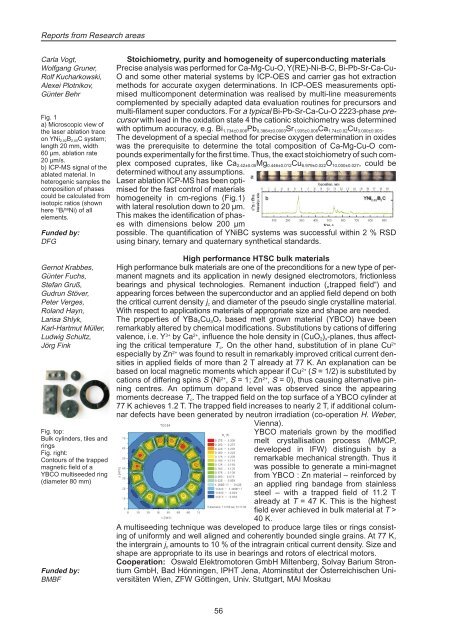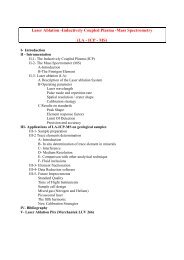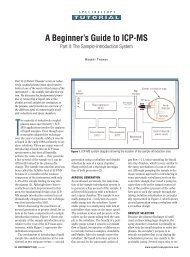Research area 1 Superconductivity and superconductors
Research area 1 Superconductivity and superconductors
Research area 1 Superconductivity and superconductors
You also want an ePaper? Increase the reach of your titles
YUMPU automatically turns print PDFs into web optimized ePapers that Google loves.
Reports from <strong>Research</strong> <strong>area</strong>s<br />
Carla Vogt,<br />
Wolfgang Gruner,<br />
Rolf Kucharkowski,<br />
Alexei Plotnikov,<br />
Günter Behr<br />
Fig. 1<br />
a) Microscopic view of<br />
the laser ablation trace<br />
on YNi 2.02 B 2.00 C system;<br />
length 20 mm, width<br />
60 µm, ablation rate<br />
20 µm/s.<br />
b) ICP-MS signal of the<br />
ablated material. In<br />
heterogenic samples the<br />
composition of phases<br />
could be calculated from<br />
isotopic ratios (shown<br />
here 11 B/ 58 Ni) of all<br />
elements.<br />
Funded by:<br />
DFG<br />
Stoichiometry, purity <strong>and</strong> homogeneity of superconducting materials<br />
Precise analysis was performed for Ca-Mg-Cu-O, Y(RE)-Ni-B-C, Bi-Pb-Sr-Ca-Cu-<br />
O <strong>and</strong> some other material systems by ICP-OES <strong>and</strong> carrier gas hot extraction<br />
methods for accurate oxygen determinations. In ICP-OES measurements optimised<br />
multicomponent determination was realised by multi-line measurements<br />
complemented by specially adapted data evaluation routines for precursors <strong>and</strong><br />
multi-filament super conductors. For a typical Bi-Pb-Sr-Ca-Cu-O 2223-phase precursor<br />
with lead in the oxidation state 4 the cationic stoichiometry was determined<br />
with optimum accuracy, e.g. Bi 1.734±0.006 Pb 0.3864±0.0003 Sr 1.935±0.006 Ca 1.74±0.02 Cu 3.000±0.003 .<br />
The development of a special method for precise oxygen determination in oxides<br />
was the prerequisite to determine the total composition of Ca-Mg-Cu-O compounds<br />
experimentally for the first time. Thus, the exact stoichiometry of such complex<br />
composed cuprates, like Ca 2.42±0.05 Mg 0.446±0.012 Cu 6.979±0.022 O 10.000±0.027 , could be<br />
determined without any assumptions.<br />
Laser ablation ICP-MS has been optimised<br />
for the fast control of materials<br />
homogeneity in cm-regions (Fig.1)<br />
with lateral resolution down to 20 µm.<br />
This makes the identification of phases<br />
with dimensions below 200 µm<br />
possible. The quantification of YNiBC systems was successful within 2 % RSD<br />
using binary, ternary <strong>and</strong> quaternary synthetical st<strong>and</strong>ards.<br />
Gernot Krabbes,<br />
Günter Fuchs,<br />
Stefan Gruß,<br />
Gudrun Stöver,<br />
Peter Verges,<br />
Rol<strong>and</strong> Hayn,<br />
Larisa Shlyk,<br />
Karl-Hartmut Müller,<br />
Ludwig Schultz,<br />
Jörg Fink<br />
Fig. top:<br />
Bulk cylinders, tiles <strong>and</strong><br />
rings<br />
Fig. right:<br />
Contours of the trapped<br />
magnetic field of a<br />
YBCO multiseeded ring<br />
(diameter 80 mm)<br />
Funded by:<br />
BMBF<br />
High performance HTSC bulk materials<br />
High performance bulk materials are one of the preconditions for a new type of permanent<br />
magnets <strong>and</strong> its application in newly designed electromotors, frictionless<br />
bearings <strong>and</strong> physical technologies. Remanent induction („trapped field“) <strong>and</strong><br />
appearing forces between the superconductor <strong>and</strong> an applied field depend on both<br />
the critical current density j c <strong>and</strong> diameter of the pseudo single crystalline material.<br />
With respect to applications materials of appropriate size <strong>and</strong> shape are needed.<br />
The properties of YBa 2 Cu 3 O 7 based melt grown material (YBCO) have been<br />
remarkably altered by chemical modifications. Substitutions by cations of differing<br />
valence, i.e. Y 3+ by Ca 2+ , influence the hole density in (CuO 2 ) x -planes, thus affecting<br />
the critical temperature T c . On the other h<strong>and</strong>, substitution of in plane Cu 2+<br />
especially by Zn 2+ was found to result in remarkably improved critical current densities<br />
in applied fields of more than 2 T already at 77 K. An explanation can be<br />
based on local magnetic moments which appear if Cu 2+ (S = 1/2) is substituted by<br />
cations of differing spins S (Ni 2+ , S = 1; Zn 2+ , S = 0), thus causing alternative pinning<br />
centres. An optimum dop<strong>and</strong> level was observed since the appearing<br />
moments decrease T c . The trapped field on the top surface of a YBCO cylinder at<br />
77 K achieves 1.2 T. The trapped field increases to nearly 2 T, if additional columnar<br />
defects have been generated by neutron irradiation (co-operation H. Weber,<br />
Vienna).<br />
YBCO materials grown by the modified<br />
melt crystallisation process (MMCP,<br />
developed in IFW) distinguish by a<br />
remarkable mechanical strength. Thus it<br />
was possible to generate a mini-magnet<br />
from YBCO : Zn material – reinforced by<br />
an applied ring b<strong>and</strong>age from stainless<br />
steel – with a trapped field of 11.2 T<br />
already at T = 47 K. This is the highest<br />
field ever achieved in bulk material at T ><br />
40 K.<br />
A multiseeding technique was developed to produce large tiles or rings consisting<br />
of uniformly <strong>and</strong> well aligned <strong>and</strong> coherently bounded single grains. At 77 K,<br />
the intergrain j c amounts to 10 % of the intragrain critical current density. Size <strong>and</strong><br />
shape are appropriate to its use in bearings <strong>and</strong> rotors of electrical motors.<br />
Cooperation: Oswald Elektromotoren GmbH Miltenberg, Solvay Barium Strontium<br />
GmbH, Bad Hönningen, IPHT Jena, Atominstitut der Österreichischen Universitäten<br />
Wien, ZFW Göttingen, Univ. Stuttgart, MAI Moskau<br />
56





